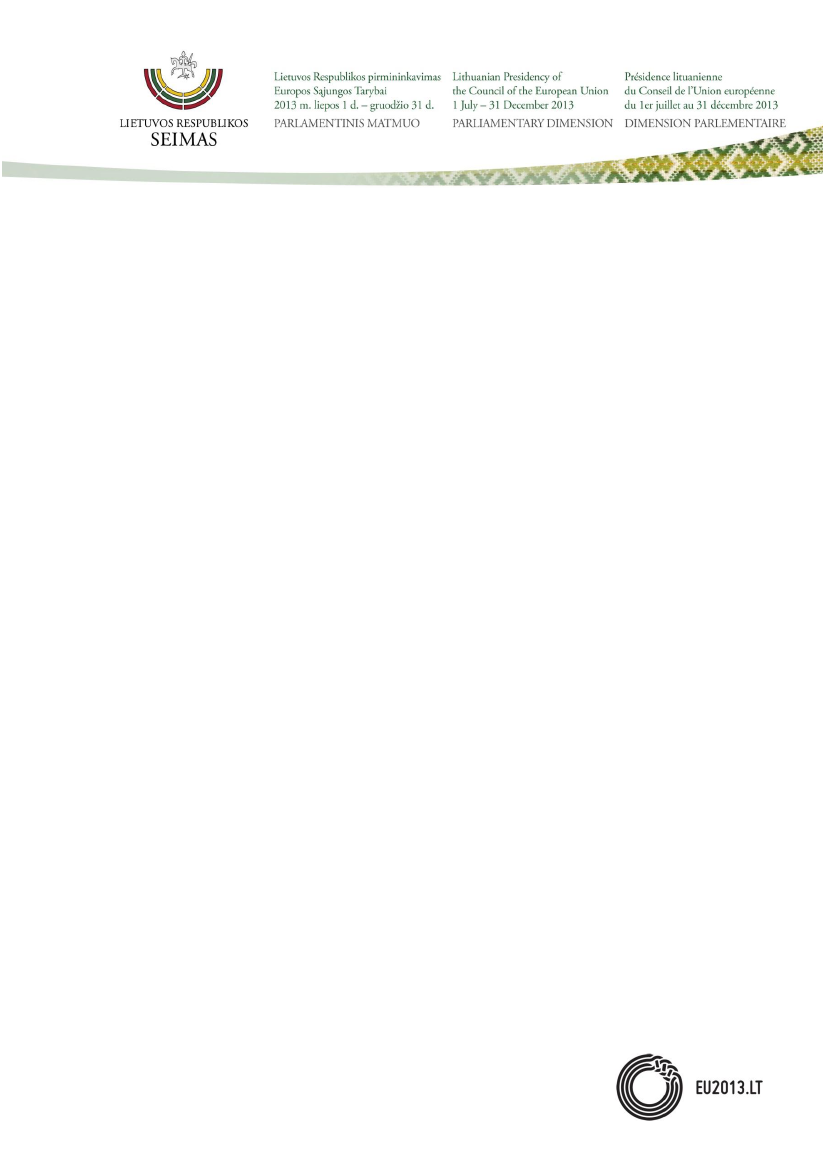Uddannelses- og Forskningsudvalget 2013-14
FIV Alm.del Bilag 10
Offentligt








MEETING OF THE CHAIRPERSONS OF THE COMMITTEES ON EDUCATION,SCIENCE AND CULTURE AND THE COMMITTEES ON THE DEVELOPMENT OFINFORMATION SOCIETY “UNITED IN DIVERSITY: POLITICAL AND SOCIALDEVELOPMENT ASPECTS OF EU LANGUAGES AND CULTURES”CONCLUSIONS26–27 September 2013, VilniusIntroductory remarksThe Meeting of the Chairpersons of the Committees on Education, Science and Culture and theCommittees on the Development of Information SocietyUnited in Diversity: Political andSocial Development Aspects of EU Languages and Cultureswas held in the Seimas of theRepublic of Lithuania on 26–27 September 2013.The Meeting focused on two topics:Machine translation of European languages: problems,challenges, prospectsandDigitalisation of a language as a part of cultural heritage.The Meeting was opened by Ms Audronė PITRĖNIENĖ, Chair of the Committee on Education,Science and Culture of the Seimas of the Republic of Lithuania. The introductory remarks werefollowed by welcome addresses by Dr Vydas GEDVILAS, Speaker of the Seimas of theRepublic of Lithuania, and Mr Rimantas SINKEVIČIUS, Minister of Transport andCommunications of the Republic of Lithuania.Session I was chaired by Ms Audronė PITRĖNIENĖ, Chair of the Committee on Education,Science and Culture, where the following keynote speakers took the floor: Dr SabineKIRCHMEIER-ANDERSEN, Director of the Danish Language Council; Mr JanTRUSZCZYŃSKI, Director General of the Directorate General for Education and Culture ofthe European Commission; Ms Maria Cristina DE PRETER, Head of the Portuguese LanguageDepartment of the Directorate General for Translation of the European Commission; DrAlgirdas SAUDARGAS, Member of the European Parliament; Dr Andrejs VASIĻJEVS,Director of Tilde.In session II, chaired by Dr Mindaugas BASTYS, Chair of the Committee on the Developmentof Information Society of the Seimas, the floor was taken by the following keynote speakers :Mr Kimmo ROSSI, Head of the Research and Innovation Sector of the Unit Data Value Chainof the Directorate General for Communications Networks, Content and Technology of theEuropean Commission; Prof Hans USZKOREIT, scientist, Chair of the META-NET ExecutiveBoard, Coordinator of META-NET and T4ME; Ms Kaisa OLKKONEN, Member of the
Gedimino pr. 53, LT-01109 Vilnius, LITHUANIATel. + 370 5 239 6762 E-mail: [email protected]
2
Executive Board of the Association DIGITALEUROPE, Vice President for GovernmentRelations of Nokia Corporation.The presentations were followed by a general debate. The Meeting concluded in considerationand adoption of the Conclusions.Conclusions of the MeetingEU policy on multilingualism in times of information technology1.Linguistic diversity is an essential characteristic of European identity and cultural heritage.This diversity ensures social participation and full citizenship to every citizen of eachMember State. Due to the processes of globalisation and migration, the importance ofknowledge of languages has particularly increased in today‟s European societies whilelanguage teaching has become one of the key objectives of EU language policy in the areaof education.The first regulation adopted by the Council of the European Economic Community (15April 1958) confirmed the equality of the official state languages of the Member States andtheir status as official and working languages of the European institutions. Since then, EUdocuments have been translated into all official languages of the EU and the EU has beenspending substantial funds on the promotion of multilingualism.During the last 60 years, Europe has become a distinct political and economic structure, yetculturally and linguistically it is still very diverse. One classic way of overcoming thelanguage barrier is to learn foreign languages. Yet without technological support, masteringall official languages of the Member States of the European Union and some 60 otherEuropean languages as well as receiving information in these languages is aninsurmountable obstacle for the citizens of Europe and its economic, political, andscientific progress.Europe‟s future sustainable growth and competitiveness depends to a large extent on itsability to embrace the digital transformation in all its complexity. In the area ofmultilingualism, information and communication technology (ICT) will offer Europeanactors tremendous advantages, not only within the common European market but also intrade relations with emerging markets of third countries. Technology solutions willeventually serve as a unique bridge between Europe‟s languages.
2.
3.
4.
Endangered European languages and linguistic diversity in the European Union5.The objective of safeguarding each and every facet of the European Union‟s cultural andlinguistic heritage has been bolstered under the Lisbon Treaty because linguistic andcultural diversity is one of the fundamental principles of the European Union, as enshrinedin Article 22 of the Charter of Fundamental Rights, which reads: „The Union shall respectcultural, religious and linguistic diversity‟. All languages, including those which areendangered, reflect historical, social, cultural and ecological knowledge and skills that formpart of the richness of the European Union.
3
6.
The European Union and the Member States are encouraged to pay more attention to theextreme danger that many European languages are in if they cannot be used tocommunicate using modern information technology and to commit wholeheartedly topreserving the diversity of the Union‟s linguistic and cultural heritage by supportingambitious protection policies within the language communities concerned and byintensifying storage and digitalisation of language resources and research and developmentof language technology.In this era of information technology, many languages are at risk of disappearing becausethey are not present in the digital technology space. Those languages which will fail toestablish their presence in information technologies and the global digital space may bedoomed to face digital extinction.The study conducted by META-NET (Network of Excellence) concludes that digitalsupport for 21 of the 30 European languages investigated is “non-existent” or “weak” atbest. Only English was assessed as having “good support”.Survival of languages, particularly of those with fewer users, can be ensured through theirfull-scale viability in the digital space. Therefore, the Meeting of the Chairpersons ofParliamentary Committees expresses concern over uneven development of languagetechnology in Europe and insufficient sustainability, applicability and completeness ofavailable language resources.
7.
8.
9.
10. Language technology has the potential of opening up new ways of multilingualcommunication, using machine translation and automatic interpretation, as well asinformation dissemination and retrieval systems. However, the pace of change in this areais so high that efforts aimed at language planning and stabilisation are no longer able toaddress every challenge in time. The fact that the market forces drive companies to givepriority to products for the most widely spoken languages results in the slow introductionand dispersion of language technology and tools and the inadequate development of digitallanguage resources for languages that are less widely used. We have to make sure that weequip all smaller and under-resourced languages with the necessary base technologies andallocate resources, financial included, to that end; otherwise these languages will not beable to serve their users in the digital space. Instead citizens will be forced by thetechnology to use another language than their own, which is a violation of their linguistichuman rights.11. The participants of the Meeting call on the Commission and the Council to adapt variousEU policies and programmes so as to support all European languages and linguisticdiversity using EU financial support tools for the period between 2014 and 2020, makingsure that programmes on education and training, youth and sport, culture and media, aswell as structural funds provide all instruments designed to promote languages in newtechnologies.12. Participants of the Meeting welcome the efforts and the results already achieved regardingthe deployment of the machine translation service (MT@EC) by the EuropeanCommission, also soon to be made available to national administrations. Participantsconsider that it is essential to concentrate special attention on the morphologically complex
4
languages, where the results so far are less convincing. For this purpose, cooperationbetween the EU institutions and national stakeholders should be encouraged.Ways to satisfy the needs of EU multilingual society in the digital space13. The participants of the Meeting welcome the EU‟s position to support substantial researchefforts to make online content more accessible across languages and to reduce linguisticand social exclusion.14. Seeking to promote multilingualism in the digital space, there needs to be, first andforemost, a much stronger focus on developing transversal skills and basic skills at alllevels and making educational resources more available in mother tongue. Schools,universities and vocational training institutions must increase access to education via openeducational resources („Rethinking Education‟).15. It is essential to promote adult language learning through the use of media, newtechnologies, cultural and leisure activities.16. The EU is a major employer of translators and an important player in the Europeantranslation market. This is why it is necessary to follow the developments in translationtraining in Europe closely and contribute to them.17. Europe badly needs high-quality machine translation software for all European and majornon-European languages in order to finally overcome language barriers and thus future-proof European languages. The participants of the Meeting are convinced that the provisionof new applications and services to citizens would create a host of new opportunities forthe European labour market and language industries.Promotable initiatives on language and its heritage resource digitalisation18. It is vital to design and develop multilingual digital resources and tools necessary formachine translation and advanced analysis of linguistic data, which are a prerequisite forbuilding quality machine translation software, thereby ensuring the status of equalityenjoyed by all official languages of the EU. The participants of the Meeting are of theopinion that digitalisation performs not merely a technological function. Digitalisation oflanguage resources and items of linguistic heritage preserves characteristic features of thelanguages concerned and keeps record of their historical development. In the digital space,language becomes crucial in expressing the identity and culture of a modern, progressiveand creative nation.19. The participants of the Meeting regret that in reality digitalisation of resources of smaller(non-commercial) European languages and their heritage is becoming a local academicmission, which is often complicated by the lack of human resources and insufficient focus,support and funding by public and commercial institutions. These circumstances constitutea systemic reason contributing to the actual digital divide among languages in Europe.20. One of the fundamental challenges is that the effort needed to describe a language is thesame, regardless whether the language has many or few speakers. The effort needed to
5
provide the necessary language resources and relevant research for the digitalrepresentation of English is exactly the same as the effort needed for Lithuanian or anyother language. There are just more speakers to share the burden and a greater market togive a proper return on investment for English. This disproportionate situation should beregulated so that every language has an equal chance to be digitally present on an advancedlevel.The participants of the Meeting encourage and welcome the initiatives which:21. prioritise funding aimed at the reduction of the digital divide so that all European languageswould come closer to the minimum EU-standard for language technology development;apply public-private partnership (PPP) principles in designing and developing multilingualdigital resources and tools;22. seek, through legal regulation, resolution of the problem of disproportionate costs ofinternational projects;23. enable consistent integration of smaller languages into multilingual scientificinfrastructures related to the design and development of digital resources and languagetechnology; ensure, at the European level, sustainability and international standards ofdigital language resources and technologies that build them, and foresee the level of theiraccessibility and availability.Overview of the presentations and debatesSESSION I: MACHINE TRANSLATION OF EUROPEAN LANGUAGES: PROBLEMS,CHALLENGES, PROSPECTSIn her presentation, Dr KIRCHMEIER-ANDERSEN, Director of the Danish LanguageCouncil, stressed that languages were closely linked to our identity and that they allowed seeingthe world from a different perspective not only from the cultural point of view but also in termsof commerce or politics. She stressed that machine translation (MT) was becoming moreprevalent and that in the future MT would be reachable instantaneously, for example on oursmartphones. The current most widespread MT resource was Google Translate, but it workedwell only for well digitised languages and only in the general domain. Dr KIRCHMEIER-ANDERSEN pointed out that market forces alone would not be sufficient to develop MTsystems, and that was why significant funds that the EU spent on the development of suchsystems should be welcomed. She noted that the development of such systems would allowinformation to flow easily between different languages in Europe.Mr Jan TRUSZCZYŃSKI, Director General of the Directorate General for Education andCulture of the European Commission, referred to the scientific conferenceUnited in diversity:the importance of languages for mobility, employment and active citizenshipthat had takenplace in the Seimas in the days preceding the Meeting. During the conference the importance oflanguages for jobs and mobility had been discussed. He stressed that languages were on top ofthe priority list for the Commission in education policy. Translation into other EU languageswas also a key factor ensuring democratic legitimacy of the EU, as European citizens requiredto access information on EU decisions and legislation in their own languages. He also
6
mentioned that, after the 2004 enlargement, the EU managed to cope with the influx of newlanguages well largely due to language processing technologies. The EU intended to continuesupporting language technologies through different funding programmes, such as the Horizon2020, for example.Ms Maria Cristina DE PRETER, Head of the Portuguese Language Department of theDirectorate General for Translation of the European Commission, mentioned that out of the6000 languages that existed in the world 40% were vulnerable. She stressed that the EU stoodfor language diversity and that it invested heavily in MT technology and had developed its ownMT system called MT@EC. She pointed out that MT could help the languages survive. One ofthe MT systems funded by the Commission and most widely used in the world wasMoses.Such systems brought us closer to the goal of enabling people in Europe to interact with eachother in their own languages. She also emphasised that the Commission saw MT as animportant factor in completing the single market in the EU.Dr Algirdas SAUDARGAS MEP, stressed that English was the contemporarylingua franca.Even if people used their native languages, English was the language connecting people. MTwas currently rooted in English but if real multilingualism was to be ensured, the situation hadto be turned upside down to root MT in native languages, not English. He underlined theimportance of other languages catching up with English, and that this could be achieved onlywith the use of public funds. He emphasised the importance of acting and thinkingglocal,i.e.strengthening local identities while at the same time increasing global interaction.Dr Andrejs VASIĻJEVS, Director of Tilde, started his presentation by pointing out that capitaland people could move freely in Europe, but that the language barrier still existed. According tohim, less than 40% of Europeans used online content in foreign languages and 46% were notable to hold a conversation in a foreign language. Technology could help overcome thelanguage barrier. MT was sometimes already good enough for publication and could savemoney and improve the competitiveness of small and medium-sized enterprises in the EU‟ssingle market. It would also enable citizens to get better acquainted with other cultures inEurope. That is why the EU should move forward towards creating a real single digitalmarketplace, which would mean that Europeans would be able to access any products orservices in their own language. This would signify a truly multilingual society. He also pointedout that globalisation was a race against time and that the dominance of English would be evenmore felt in the future. But this should encourage the EU to invest in other languages to makethe EU a truly multilingual community.The debateDuring the debate many participants stressed that all languages should be supported in the EU,not only English. But in efforts to develop effective MT more efforts should be made to digitiseEuropean languages. This would also potentially allow developing automated voiceinterpretation in the future. It was mentioned that the idea of united Europe rested onmultilingualism, not the dominance of one or two languages. Participants also spoke of the needfor the EU to develop its own strong MT sector. One of the priorities should be to introducetranslation technologies for pupils at schools. It was also important to prevent languages fromdigital extinction and thus to support the digitisation of languages to avoid the gap between the
7
real and the digital space. Concern was expressed that MT could create disincentives forEuropeans to learn other languages. It was therefore stressed that Europeans should beencouraged to learn other languages as well.SESSION II: DIGITALISATION OF A LANGUAGE AS A PART OF CULTURALHERITAGEIn his presentation Mr Kimmo ROSSI, Head of the Research and Innovation Sector of the UnitData Value Chain of the Directorate General for Communications Networks, Content andTechnology of the European Commission, stressed the barriers that the lack of languageknowledge presented in the single market. Mr ROSSI said that 80% of e-commerce in the EUwas in one language only. The EU spent around 150 million EUR on MT systems through its7th Framework Programme. Now funding for that purpose would be allocated through Horizon2020, the Connecting Europe Facility and the structural funds. Yet the development of suchtechnologies was not the same as their deployment. In this area there should be morecoordination between the Commission and the Member States. For example, in order to developautomated translation there was a need to collect and digitise linguistic resources. This couldonly be achieved by the Member States themselves, even if with the help of the Commission.The Member States should be the ones most interested in the preservation of their languagesand therefore assist the Commission in its efforts.Prof Hans USZKOREIT, Chair of the META-NET Executive Board, Coordinator of META-NET and T4ME, pointed out that technology had improved dramatically, and now robots weretalking, search engines had improved, and MT systems had advanced. He identified three majorproblems in terms of language diversity in Europe: 1) the language barrier remained one of themost significant obstacles in completing the EU single market; 2) European companies had acompetitive disadvantage because of the diversity of languages in the EU; 3) many Europeanlanguages, with the notable exception of English, were poorly digitised, which preventedeffective MT systems from being developed for these languages. Poor digitisation could evenlead to digital language death. He stressed that European companies and researchers wereleaders in MT technology but that the EU‟s competitive advantage was weakened by marketfragmentation. He singled out priority themes for researchers: developing a translingual cloud,improving social intelligence, and working on socially aware interactive assistants.Ms Kaisa OLKKONEN, Member of the Executive Board of the AssociationDIGITALEUROPE, noted that consumers wanted services in their own languages. Thereforecompanies on the internet that provided services or information in local languages had anadvantage over those than only operated in English. Even if it was costly to create content in alocal language, at the end it paid off. Moreover, ICT technologies could help harness economiesof scale. In the EU single market companies were faced with a load of national regulations thatcame only in the national language. This prevented many companies from starting operations inanother Member State. More efficient and affordable MT systems would allow solving thisproblem.The debateThe participants stressed that languages in the EU, especially the smaller ones, were vulnerableand that digitisation was one of the measures to protect them. That is why projects like
8
METANET and others should be funded from the EU and/or national budgets. It was stressedthat public funding could lead to landmark technologies, like the GPS, which had beendeveloped with the help of the government in the United States. An idea was raised that the EUshould contemplate the creation of a central repository for digital content in order to protect thelinguistic and cultural diversity.








